Introduction
A web service is a web application which is basically a class consisting of methods that could be used by other applications. Active Server Methods (ASMX) is a solution put forwarded by Microsoft to create web services. ASMX supports Simple Object Access Protocol (SOAP) which is based on HTTP.
ASMX web services can only be hosted in IIS and must be developed under web project.
Here is a typical senario how we use ASMX webservice to construct our applications.

Outline
- create a ASMX web servcie
- create a proxy
- consume the web service
Create a webservice
First, create a web project
enable routing
-
webforms project
-
webapi/mvc project
need to enable router for asmx, modify App_Start\RouteConfig.cs
public class RouteConfig { public static void RegisterRoutes(RouteCollection routes) { routes.IgnoreRoute("{*x}", new { x = @".*\.asmx(/.*)?" }); ... } }
Create a asmx webservice
right click project > new item > asmx webservice
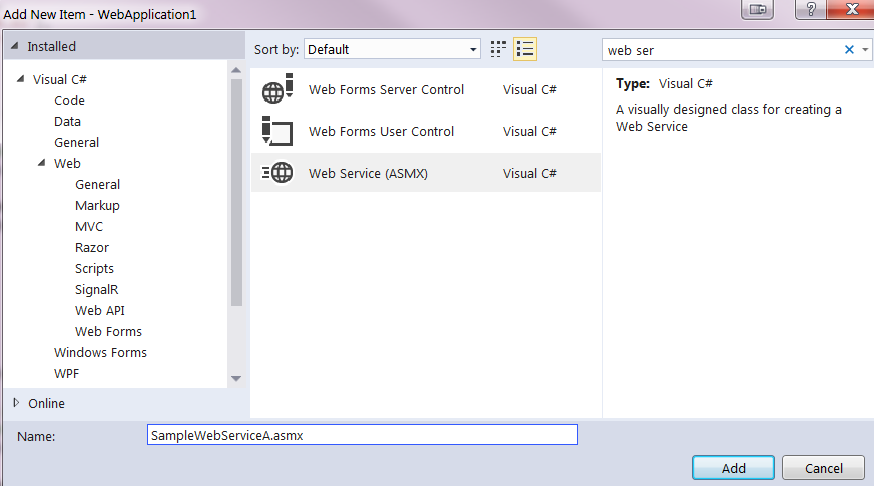
Here is the code:
namespace WebApplication1.WebServices
{
/// <summary>
/// Summary description for SampleWebService
/// </summary>
[WebService(Namespace = "http://tempuri.org/")]
[WebServiceBinding(ConformsTo = WsiProfiles.BasicProfile1_1)]
[System.ComponentModel.ToolboxItem(false)]
// To allow this Web Service to be called from script, using ASP.NET AJAX, uncomment the following line.
// [System.Web.Script.Services.ScriptService]
public class SampleWebService : System.Web.Services.WebService
{
[WebMethod]
public string HelloWorld()
{
return "Hello World";
}
}
}
Please note:
- inherit
System.Web.Services.WebServiceis optional, but it provides session/application state management, caching features - Namespace is used to diffentiate other webservice with ours
- WebServiceBining is used to validate the specification of this webservice, we could disable it by set ConformsTo = WsiProfiles.None
- Attribute [WebService] for class and [WebMethod] for method is required
Create a new method
Create a new method in the webservice, decorate with [WebMethod], returns an object
[WebService(Namespace = "http://tempuri.org/")]
[WebServiceBinding(ConformsTo = WsiProfiles.BasicProfile1_1)]
[System.ComponentModel.ToolboxItem(false)]
// To allow this Web Service to be called from script, using ASP.NET AJAX, uncomment the following line.
// [System.Web.Script.Services.ScriptService]
public class SampleWebService : System.Web.Services.WebService
{
[WebMethod]
public string HelloWorld()
{
return "Hello World";
}
[WebMethod]
[ScriptMethod(UseHttpGet = true, ResponseFormat = ResponseFormat.Json)]
public Student GetStudent()
{
Context.Response.Clear();
Context.Response.ContentType = "application/json";
return new Student()
{
Name = "andy",
Age = 25,
DateOfBirth = new DateTime(1993, 5, 12)
};
}
}
public class Student
{
public string Name { get; set; }
public int Age { get; set; }
public DateTime DateOfBirth { get; set; }
}
ctrl + f5, run

it lists current endpoints, we can also add ?wsdl to get wsdl document

click an endpoint

here is the description, click Invoke to make a mock call
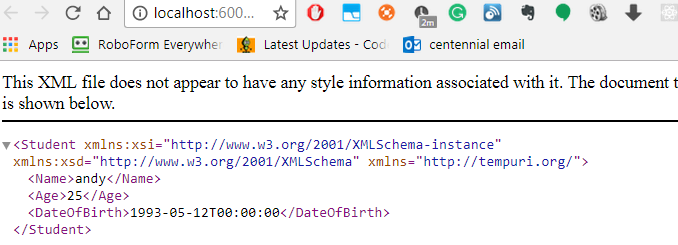
Allow GET, Add JSON
asmx uses SOAP protocol and by default it is POST request.
modify web.config
<system.web>
...
<webServices>
<protocols>
<add name="HttpGet"/>
<add name="HttpPost"/>
</protocols>
</webServices>
</system.web>
add new attribute before the method:
[ScriptMethod(UseHttpGet = true, ResponseFormat = ResponseFormat.Json)]
we can get result use GET request:

By default, the result is XML format, we can add Content-Type=application/json in the header to get json result
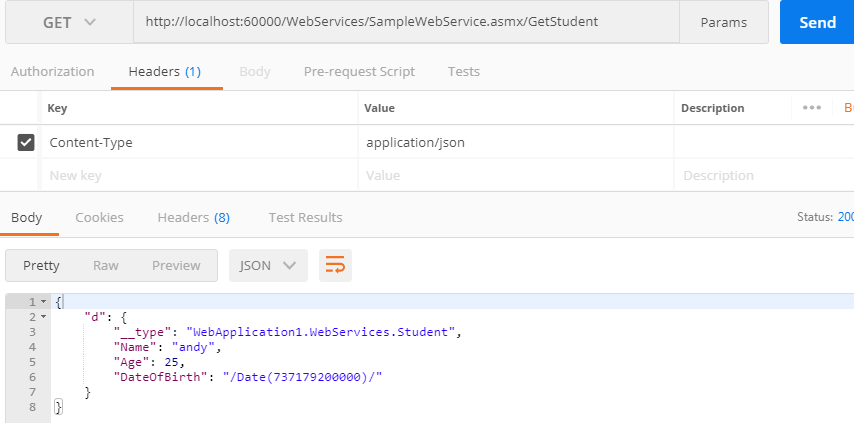
Please note that by default, json result is included in d property
Improve endpoint: enable session state
If we need session management, cache feature, pls remember our webservice class has to inherit System.Web.Services.WebService class
in order to let the server maintains the session state, we just modify the attribute [WebMethod] to [WebMethod(EnableSession =true)]
Server will keep the session state for this endpoint
In the code, we call global Session object to get the saved state. Session object is used like a dictionary.
WebMethod(EnableSession =true)]
[ScriptMethod(UseHttpGet = true, ResponseFormat = ResponseFormat.Json)]
public Student GetStudent()
{
Student s = (Student) Session["student"];
...
}
Improve endpoint 2
-
add cache to endpoint
[WebMethod(EnableSession =true, Description ="this endpoint returns a student", CacheDuration = 60)] [ScriptMethod(UseHttpGet = true, ResponseFormat = ResponseFormat.Json)] public Student GetStudent() {...}here CacheDuration is seconds
-
add buffer to endpoint
[WebMethod(EnableSession =true, Description ="this endpoint returns a student", CacheDuration = 60, BufferResponse = true)] [ScriptMethod(UseHttpGet = true, ResponseFormat = ResponseFormat.Json)] public Student GetStudent() {...} -
add alias to endpoint if we have overloading endpoints
[WebMethod(EnableSession =true, MessageName = "GetStudentNewName")] [ScriptMethod(UseHttpGet = true, ResponseFormat = ResponseFormat.Json)] public Student GetStudent() {...} -
enable ajax call
uncomment attribute
[System.Web.Script.Services.ScriptService] public Student GetStudent() {...}
Consume the webservice
The client could be web application(web forms, mvc), console, windows form or any other applications by other languages.
Here is an example for .NET project (web form, console, windows form)
Create proxy class
right click Services Reference > add service reference
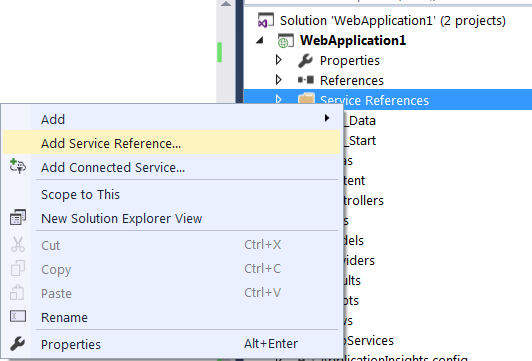
Enter webservice wsdl file, click go. Or we can click discover to let it find all webservices in current project.

Select SOAP > ok, the proxy class will be created
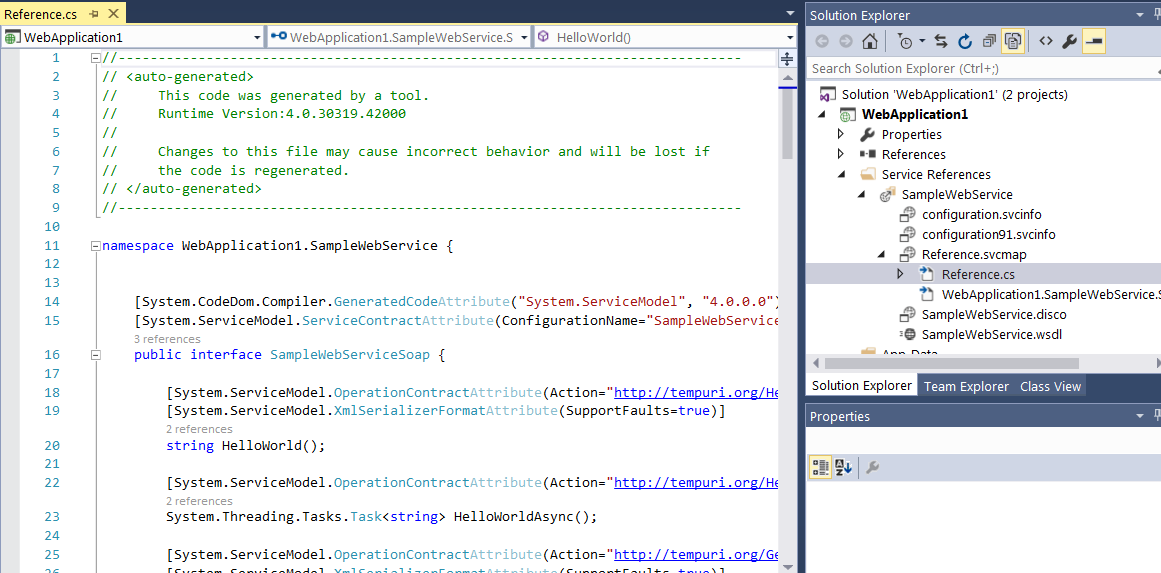
Create a client
Here, we create a web form to demostrate
create a new webform, add a few controls
<%@ Page Language="C#" AutoEventWireup="true" CodeBehind="SampleWebServiceClient.aspx.cs" Inherits="WebApplication1.SampleWebServiceClient" %>
<!DOCTYPE html>
<html xmlns="http://www.w3.org/1999/xhtml">
<head runat="server">
<title></title>
<link rel="stylesheet" href="https://maxcdn.bootstrapcdn.com/bootstrap/3.3.7/css/bootstrap.min.css">
</head>
<body>
<form id="form1" runat="server">
<div class="container">
<table class="table table-hover table-bordered">
<tr>
<td colspan="2">
<asp:Button ID="btnLoad" runat="server" Text="Load Student" OnClick="btnLoad_Click" /></td>
</tr>
<tr>
<td>Name</td>
<td>
<asp:Label ID="lblName" runat="server" Text=""></asp:Label></td>
</tr>
<tr>
<td>Age</td>
<td>
<asp:Label ID="lblAge" runat="server" Text=""></asp:Label></td>
</tr>
<tr>
<td>Date of Birth</td>
<td>
<asp:Label ID="lblDob" runat="server" Text=""></asp:Label></td>
</tr>
</table>
</div>
</form>
</body>
</html>
In the backend
public partial class SampleWebServiceClient : System.Web.UI.Page
{
protected void Page_Load(object sender, EventArgs e)
{
}
protected void btnLoad_Click(object sender, EventArgs e)
{
var client = new SampleWebServiceSoapClient("SampleWebServiceSoap12");
var student = client.GetStudent();
lblName.Text = student.Name;
lblAge.Text = student.Age.ToString();
lblDob.Text = student.DateOfBirth.ToString("yyyy-MM-dd");
}
}
It looks like

Please note that when we click the Load button, it creates new a proxy instance and help us make the SOAP call. Finally, when we click the button in the page, we got

Authentication
todo…
-
Previous
SQL Server Reporting Services Tutorial 5 - Integrate reports in web page -
Next
ASP.NET WCF Service Tutorial